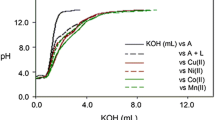Summary
Polymeric complexes prepared by solid-solution reactions, from 2-hydroxy-1-naphthaldehyde oxaldihydrazone (HNODH) and 2-hydroxy-1-naphthaldehyde malondihydrazone (HNMDH), had the empirical composition M(L-2H)·nH2O where M=FeII, MnII, CoII, NiII, CuII, ZnII, CdII and HgII; L=HNODH, HNMDH andn=0,1, 2. The complexes, which are intensely coloured and insoluble in common organic solvents, were characterized by elemental analysis, magnetic susceptibility, electronic and i.r. spectral data. The absence of anions indicates that the ligands which bind the metal ions from the hydroxyl and the imino groups have been deprotonated.
Similar content being viewed by others
References
K. K. Narang and R. A. Lal,Transition Met. Chem.,1, 260 (1976).
K. K. Narang and R. M. Dubey,Ind. J. Chem.,21A, 830 (1982).
K. K. Narang and Miss Aruna Aggarwal,Transition Met. Chem.,2, 29 (1977).
R. C. Aggarwal and K. K. Narang,Ind. J. Chem.,14A, 64 (1976).
M. Mashima,Bull. Chem. Soc. Jpn.,35, 2020, 338 (1962).
A. I. Vogel,A Text Book of Quantitative Inorganic Analysis Including Elementary Instrumental Analysis, ELBS London, 1978.
B. N. Figgis and J. Lewis in J. Lewis and R. G. Wilkins (Eds.),Magnetochemistry of Complex Compounds in Modern Coordination Chemistry, Interscience, New York, p. 403, 1960.
S. W. Hua, C. R. Rossman, H. B. Gray, G. S. Hammond, H. J. SchugarInorg. Chem.,11, 1990 (1972).
C. Lorenzini, C. Pelizzi, G. Pelizzi and G. Predicri,J. Chem. Soc., Dalton Trans., 721 (1983).
S. Lahiry and V. K. Anand,Chem. Comm.,18, 111 (1971).
K. M. Kanth, K. B. Pandeya and H. L. Nigam,Ind. J. Chem.,11, 1031 (1973).
S. C. Nyburg and J. C. Wood,Inorg. Chem.,3, 468 (1964).
G. O. Carlisle and D. A. Crutchfield,Inorg. Nucl. Chem., Lett.,8, 443 (1972).
E. K. Barefield, D. N. Bush and S. M. Nelson,Quart. Rev.,22, 457 (1968).
A. B. P. Lever,Inorganic Electronic Spectroscopy, Elsevier, Amsterdam, p. 302, 1968.
T. M. Dunn, in J. Lewis, and R. G. Wilkins (Eds),Visible and Ultraviolet Spectra of Complex Compounds in Modern Coordination Chemistry, Interscience, New York, 1960.
K. K. Narang and R. A. Lal,Transition Met. Chem.,2, 100 (1977).
K. Nakamoto,Infrared and Raman Spectra of Inorganic and Coordination Compounds, Wiley Interscience, New York, 1978.
K. K. Narang and Miss A. Aggarwal,Inorg. Chim Acta,9, 137 (1974).
Author information
Authors and Affiliations
Rights and permissions
About this article
Cite this article
Narang, K.K., Singh, M.K. Polymeric complexes of bivalent transition metal ions with 2-hydroxy-1-naphthaldehyde oxaldihydrazone and 2-hydroxy-1-naphthaldehyde malondihydrazone. Transition Met Chem 12, 385–388 (1987). https://doi.org/10.1007/BF01171642
Received:
Revised:
Issue Date:
DOI: https://doi.org/10.1007/BF01171642




